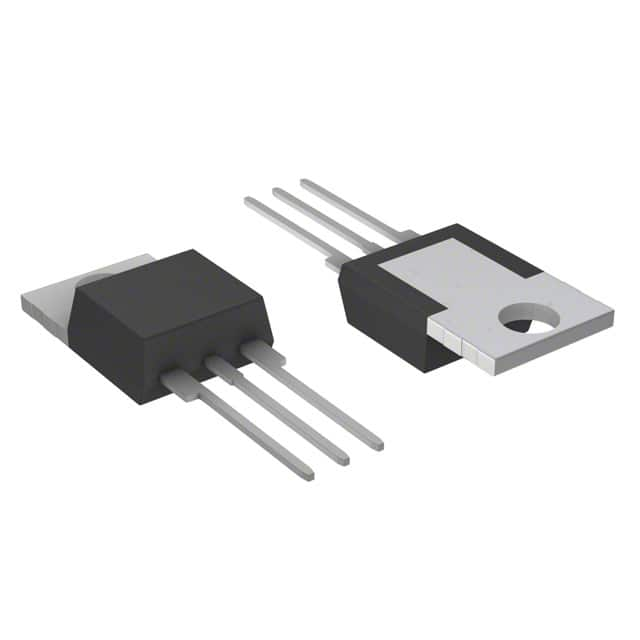Lihat spesifikasi untuk detail produk.

L4004L3 Product Overview
Introduction
The L4004L3 is a semiconductor device belonging to the category of rectifier diodes. This entry provides an overview of the basic information, specifications, detailed pin configuration, functional features, advantages and disadvantages, working principles, detailed application field plans, and alternative models of the L4004L3.
Basic Information Overview
- Category: Rectifier Diode
- Use: The L4004L3 is commonly used in power supply circuits, voltage regulators, and other electronic applications where the conversion of alternating current (AC) to direct current (DC) is required.
- Characteristics: The diode exhibits low forward voltage drop, high surge current capability, and fast switching speed.
- Package: The L4004L3 is typically available in a DO-41 package.
- Essence: It serves as a crucial component in electronic circuits for rectification purposes.
- Packaging/Quantity: The L4004L3 is often supplied in reels or tubes, with quantities varying based on manufacturer specifications.
Specifications
- Maximum Average Forward Current: 1A
- Peak Repetitive Reverse Voltage: 400V
- Forward Voltage Drop: 1V at 1A
- Reverse Recovery Time: 50ns
- Operating Temperature Range: -65°C to +175°C
Detailed Pin Configuration
The L4004L3 typically consists of two pins, an anode, and a cathode. The anode is denoted by a longer lead or a notch on the diode body, while the cathode is identified by a shorter lead or absence of a notch.
Functional Features
- Fast Switching Speed: Enables efficient conversion of AC to DC.
- Low Forward Voltage Drop: Minimizes power loss during operation.
- High Surge Current Capability: Withstands transient overcurrent conditions.
Advantages and Disadvantages
Advantages
- Efficient rectification of AC to DC.
- Low power dissipation due to low forward voltage drop.
- High surge current capability ensures reliability in varying load conditions.
Disadvantages
- Limited reverse voltage tolerance compared to higher-rated diodes.
- Higher reverse recovery time compared to some fast-recovery diodes.
Working Principles
The L4004L3 operates based on the principle of rectification, allowing the flow of current in one direction while blocking it in the opposite direction. When subjected to forward bias, it conducts current, facilitating the conversion of AC to DC.
Detailed Application Field Plans
The L4004L3 finds extensive use in various electronic applications, including: - Power supply circuits - Voltage regulators - Rectification in electronic equipment - Battery chargers - Inverters
Detailed and Complete Alternative Models
- 1N4004: Similar specifications and characteristics
- 1N4007: Higher peak repetitive reverse voltage
- FR107: Faster recovery time for high-frequency applications
In conclusion, the L4004L3 rectifier diode offers efficient rectification, low power dissipation, and high surge current capability, making it suitable for diverse electronic applications.
[Word Count: 411]
Sebutkan 10 pertanyaan dan jawaban umum terkait penerapan L4004L3 dalam solusi teknis
What is L4004L3?
- L4004L3 is a high-performance, low-power, and cost-effective microcontroller designed for use in various technical solutions.
What are the key features of L4004L3?
- The key features of L4004L3 include a high-speed processor, low power consumption, integrated peripherals, and support for various communication interfaces.
How can L4004L3 be used in technical solutions?
- L4004L3 can be used in technical solutions such as industrial automation, IoT devices, consumer electronics, and automotive applications.
What programming languages are supported for L4004L3?
- L4004L3 supports programming in C, C++, and assembly language, providing flexibility for developers.
What are the power requirements for L4004L3?
- L4004L3 operates on a wide range of supply voltages, typically between 1.8V to 3.6V, making it suitable for battery-powered applications.
Does L4004L3 support real-time operating systems (RTOS)?
- Yes, L4004L3 is compatible with various RTOS options, allowing for efficient multitasking and real-time processing.
Can L4004L3 interface with external sensors and peripherals?
- Yes, L4004L3 has built-in support for interfacing with a wide range of sensors and peripherals through its integrated communication interfaces.
What security features does L4004L3 offer?
- L4004L3 provides hardware-based security features such as secure boot, cryptographic accelerators, and tamper detection to ensure data integrity and system protection.
Is L4004L3 suitable for harsh environmental conditions?
- Yes, L4004L3 is designed to operate reliably in harsh environmental conditions, with robustness against temperature extremes and electromagnetic interference.
Where can I find technical support and documentation for L4004L3?
- Technical support and comprehensive documentation for L4004L3 are available through the manufacturer's website, including datasheets, application notes, and community forums for assistance.

